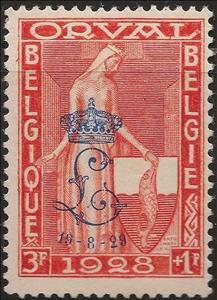Stamp: Orval Abbey - Lady Mathilde and blazon Orval (Belgium 1929)
Orval Abbey - Lady Mathilde and blazon Orval (Belgium 1929)
19 August (Belgium ) within release Orval overprinted with L and crown goes into circulation Stamp Orval Abbey - Lady Mathilde and blazon Orval face value 3+1 Belgian franc
| Stamp Orval Abbey - Lady Mathilde and blazon Orval in catalogues | |
|---|---|
| Michel: | Mi: BE 241I |
| Belgium: | Bel: BE 272G |
Stamp is vertical format.
Issue on the occasion of the laying of the first stone for the reconstruction of the abbey by Prince Leopold.Also in the issue Orval overprinted with L and crown:
- Stamp - Orval Abbey - Lady Mathilde and blazon Orval face value 1.75+0.25;
- Stamp - Orval Abbey - Lady Mathilde and blazon Orval face value 2+0.40;
- Stamp - Orval Abbey - Lady Mathilde and blazon Orval face value 3+1;
- Stamp - Orval Abbey - Lady Mathilde and blazon Orval face value 10+10;
- Stamp - Orval Abbey - Modern Gothic Vaults face value 5+5;
- Stamp - Orval Abbey - Modern Gothic Vaults face value 25+5;
- Stamp - Orval Abbey - Modern Gothic Vaults face value 35+10;
- Stamp - Orval Abbey - Modern Gothic Vaults face value 60+15;
Stamp Orval Abbey - Lady Mathilde and blazon Orval it reflects the thematic directions:
A church building, often simply called a church, is a building used for Christian religious activities, particularly worship services. The term in its architectural sense is most often used by Christians to refer to their religious buildings, but it is sometimes used (by analogy) for buildings of other religions. In traditional Christian architecture, the church is often arranged in the shape of a Christian cross. When viewed from plan view the longest part of a cross is represented by the aisle and the junction of the cross is located at the altar area. Towers or domes are often added with the intention of directing the eye of the viewer towards the heavens and inspiring church visitors. Modern church buildings have a variety of architectural styles and layouts; many buildings that were designed for other purposes have now been converted for church use; and, similarly, many original church buildings have been put to other uses. The earliest identified Christian church was a house church founded between 233 and 256. During the 11th through 14th centuries, a wave of building of cathedrals and smaller parish churches occurred across Western Europe. A cathedral is a church, usually Roman Catholic, Anglican, Oriental Orthodox or Eastern Orthodox, housing the seat of a bishop.
A coat of arms is an heraldic visual design on an escutcheon (i.e. shield), surcoat, or tabard. The coat of arms on an escutcheon forms the central element of the full heraldic achievement which in its whole consists of shield, supporters, crest, and motto. A coat of arms is traditionally unique to an individual person, family (except in the United Kingdom), state, organisation or corporation.
Sculpture is the branch of the visual arts that operates in three dimensions. Sculpture is the three-dimensional art work which is physically presented in the dimensions of height, width and depth. It is one of the plastic arts. Durable sculptural processes originally used carving (the removal of material) and modelling (the addition of material, as clay), in stone, metal, ceramics, wood and other materials but, since Modernism, there has been almost complete freedom of materials and process. A wide variety of materials may be worked by removal such as carving, assembled by welding or modelling, or moulded or cast.


